How to Visit Kassala and Hike the Taka Mountains
Ultimate Sudan Travel GuideKassala and the Taka Mountains
This travel blog contains everything you need to know to visit Kassala independently and all the best things to see and do there. It includes how to travel to Kassala with public transport, where to stay, what to eat and how to stay safe during your visit. I also provide clear directions for hiking the Taka mountains, which afford beautiful views all the way to Eritrea. This is part of my comprehensive Sudan travel guide.
What to Do in Kassala
I love hiking and Kassala is home to the most beautiful hikes in the parts of Sudan that are accessible to visitors (if not the whole country). It’s even worth the 40+ degree temperatures. The city is dominated by the towering stone peaks of the Taka mountains, which rise out of the desert on its eastern side. If hiking isn’t your thing, Kassala is also a great city to hang out and relax in, with a bustling market, chill vibe, and plenty of tea houses to choose from.
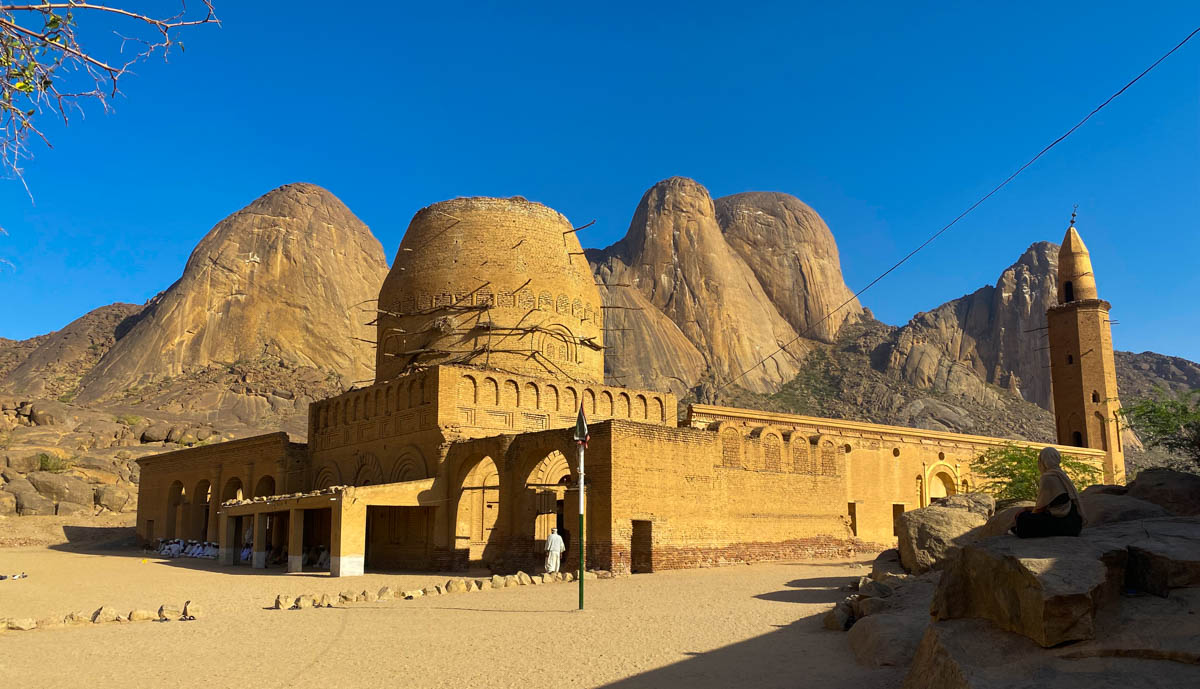
Men pray at the beautiful Khatmiyah Mosque.
Hiking the Taka Moutains
As an avid hiker, the Taka Mountains were the star attraction for me and the reason why I absolutely insisted on visiting Kassala while I was in Sudan. The mountains look like a group of giant monolithic boulders and are visible from anywhere in the city. They’re also interesting in that, despite being next to a city of almost half a million people, there are no real hiking trails. Any hike here is a scramble over rocks and boulders.
The main entrance of the Taka Mountains National Park is at 15.428978, 36.426288 and it’s marked as Toteil Natural Mountain Park on Maps.Me. It’s not clearly marked in English on Google Maps, but is located here. From the town centre, you can walk there in just over an hour or you can take a bus from the central bus station. The cost is no more than $0.60. The location is about ten minutes walk from the Khatmiyah Mosque, so you can easily visit both together.
The base of the mountains is clearly marked by a gateway in the shape of a traditional pottery Sudanese coffee pot. This is one of the few places in Sudan that feels like someone’s actually tried to develop it a bit for tourists. After passing through the gateway, you’ll find myriad cafes serving traditional coffee and snacks. Most locals who visit see this as a scenic spot to relax and never venture further up into the mountains.
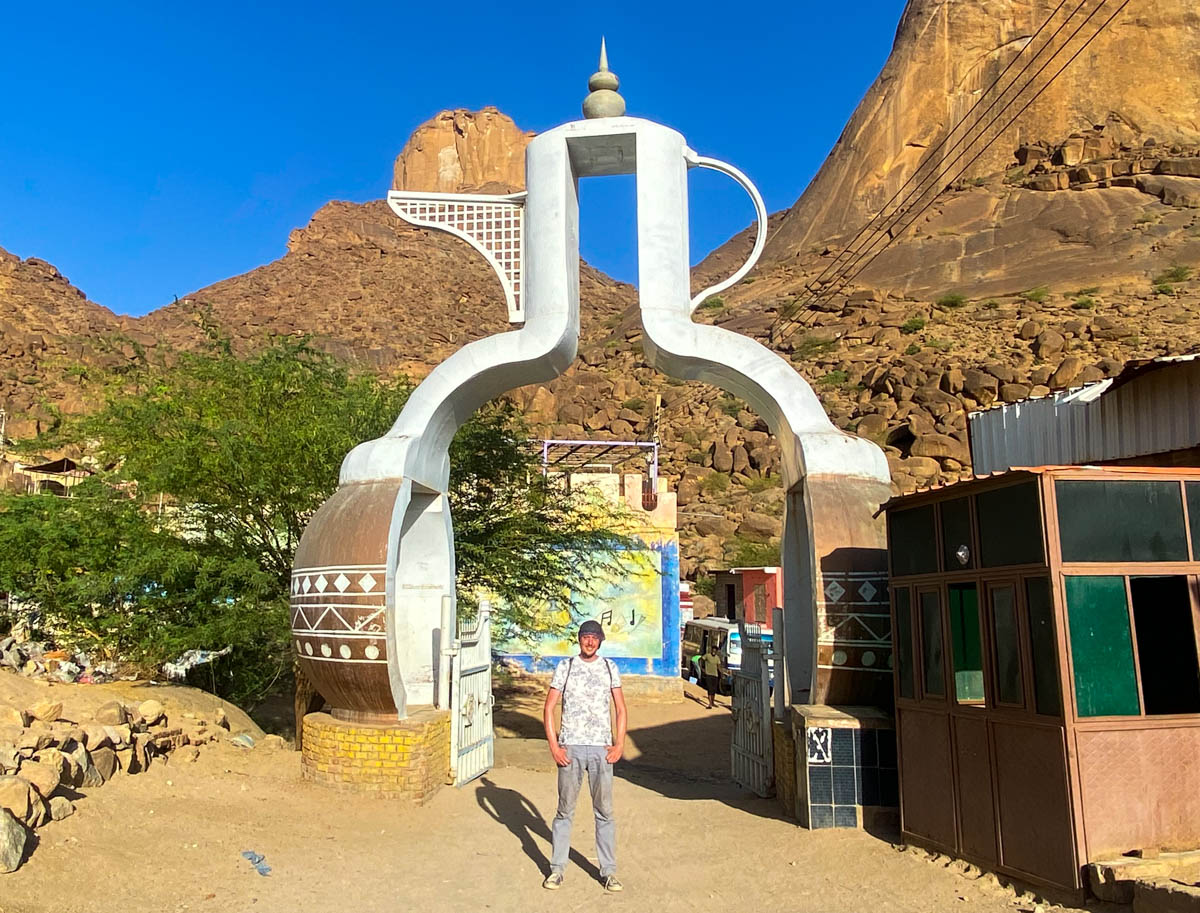
The gateway to the Taka Mountains Nature Preserve
There are several paths through the cafes, but in the end they all finish in a mass of boulders. If you want to hike the Taka Mountains, you have to find your own path. It’s actually quite easy – just set your sights on where you want to go and keep walking. Directly east of the cafes is a huge monolith that’s far too steep to hike, but the shoulders on either side of it have quite gentle slopes. We set our sights on the left shoulder and were able to hike our way to the top in about an hour.
From the top, you have views on both sides – back over the city of Kassala and its orchards to the west and across an incredibly flat plain to the border with Eritrea to the east. At sunset, the mountains cast long shadows over the plain and the light gives it a beautiful orange hue. It’s a great place to stop for a picnic, as we did. Afterwards, you can either hike back the same way to the cafes or continue down the western side of the mountains. We took the western route and it was only about forty minutes to the bottom.
Once at the western foot of the mountain, you will be on a plain dotted with tiny traditional villages. We ended up in a village of about half a dozen little round huts made from dry grass and enclosed by a circular fence of more dry grass. It was already so dark that we couldn’t even find the road out. However, a couple of friendly villagers, despite not speaking any English, kindly pointed us to the track towards the main road. From there, it was about a two kilometre walk to the road, where we easily caught a bus back to Kassala town centre for $0.60 each. If you can’t find a bus, I’m sure hitching a lift would be easy enough as well.
The hike was beautiful and I would highly recommend it to anyone visiting Kassala. Sudan is extremely hot at most times of the year, so it’s better to hike at either sunset or sunrise. You’ll also get a beautiful view of either the sun rising over the next mountain range over the Eritrean border or setting over Kassala. I suspect the sunrise is the more beautiful, although we saw the sunset.
If I’d had the time, I would’ve liked to have gone back to the mountains another day and tried climbing higher to the north and south of the cafes, but that will have to wait for another trip. It would also have been interesting to explore the traditional villages on the western side of the mountains a bit more, but it was already too dark by the time we reached that area. These are real people living real lives in a way that probably hasn’t changed much for thousands of years.
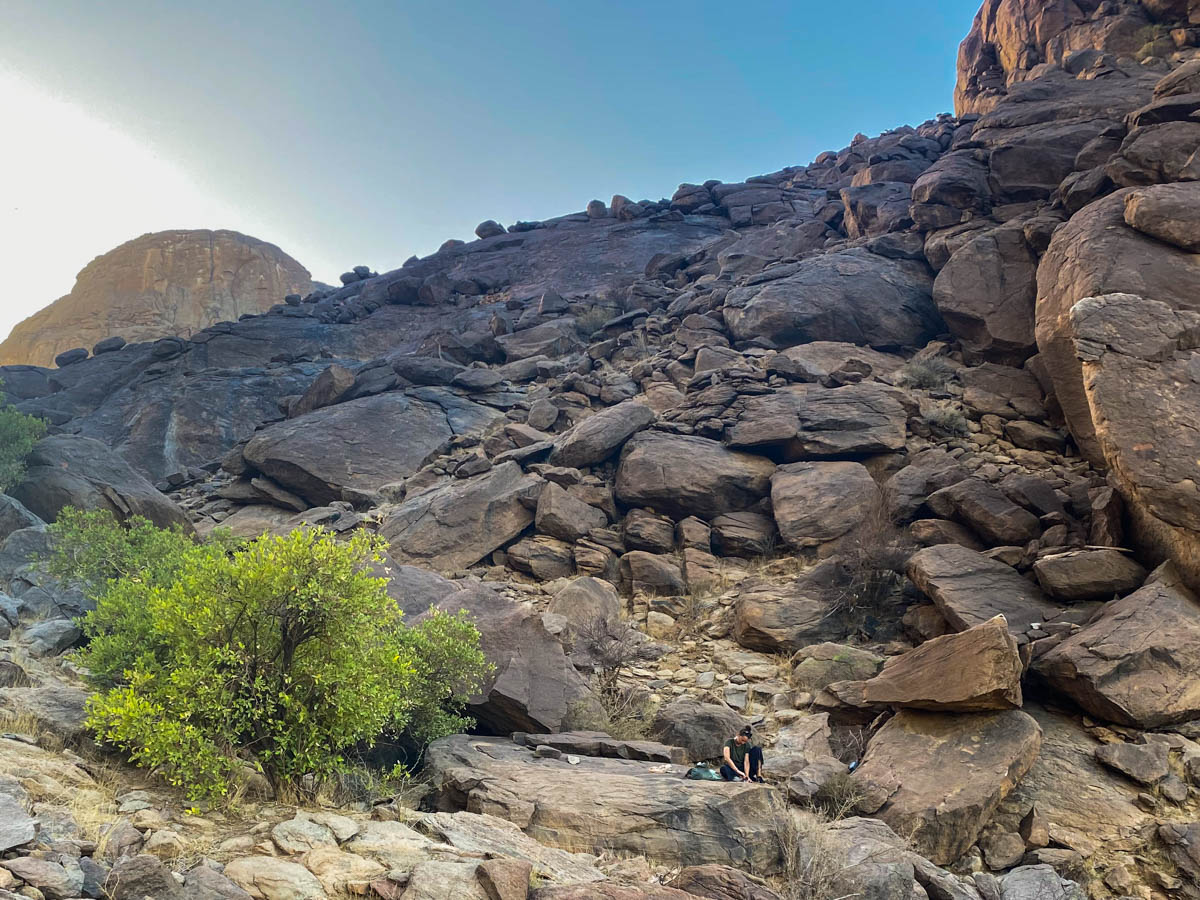
This is what you’ll face during your hike – there is not path through the Taka Moutains, you have to find your own way between the boulders. Notice how small Anna looks in the foreground.
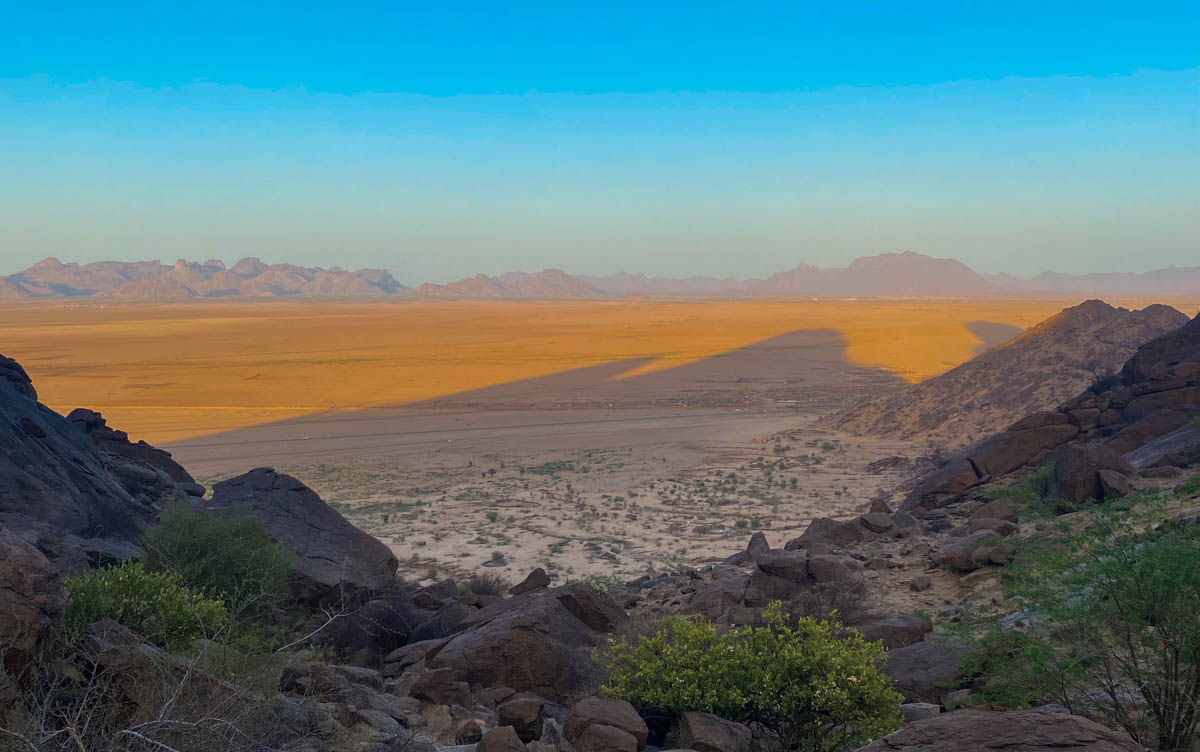
The sunset turned the plains between the Taka Mountains and Eritrea a brilliant orange. More that worth the effort of scrambling to the top.
The Khatmiyah Mosque
I have visited a lot of Arab countries and seen a lot of mosques, but this one was special even for me. Partly it’s the beautiful location at the base of the Taka mountains, partly it’s the beautiful and uniquely shaped building and partly it’s the friendliness of the people who come here to pray.
The Khatmiyah is the largest Sufi order in Sudan, Eritrea and Ethiopia and the mosque is an important centre for its followers. It’s also the final resting place of Hassan al Mirghani, who was instrumental in spreading Khatmiyah Sufism in Sudan before his death in 1869. His original tomb, built on the same spot, was burnt down in the 1880’s and the mosque built in its place. It’s also said that the soil beneath it was brought from Mecca, making it even holier.
When I arrived at the Khatmiyah mosque, a group of men were praying outside the front, so I stopped and waited respectfully for them to finish before entering. At the entrance, I met a very friendly man who spoke good English. We chatted for a while and he told me that I’m welcome to go inside, but to please remove my shoes, which I did. Later, walking through the courtyard, I was jumping between shadows to avoid the hottest areas of sand, which were scalding from the 40+ degree sun.
The columns, tower and courtyard of the Khatmiyah mosque are beautiful, as is the tranquil atmosphere at the base of the Taka Mountains. The main circular dome contains the tomb of Hassan al Mirghani. Local legend says that when it rains the sarcophagus remains dry. Given how rare rain is in Sudan, you’re unlikely to be able to test this theory.
The Khatmiyah mosque is located in the eastern part of Kassala, near the entrance to the Taka Mountains National Park. Its coordinates are 15.431833, 36.421828 and it’s marked as the Historical El-Said Alhassan Mosque on Maps.Me. On Google Maps, it’s the El Sayed El Hassan Mosque. From the town centre, you can walk there in about one hour or take a minibus from the main bus station. The cost is no more than $0.60.
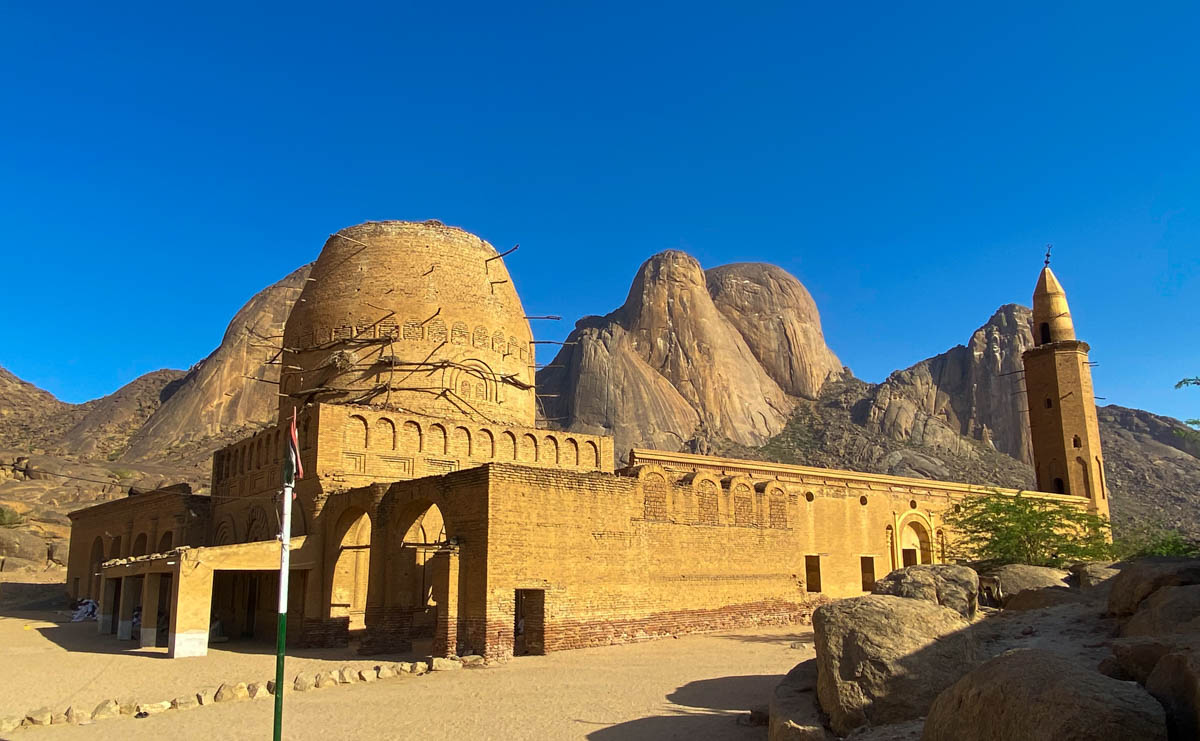
Men praying outside the Khatmiyah Mosque.
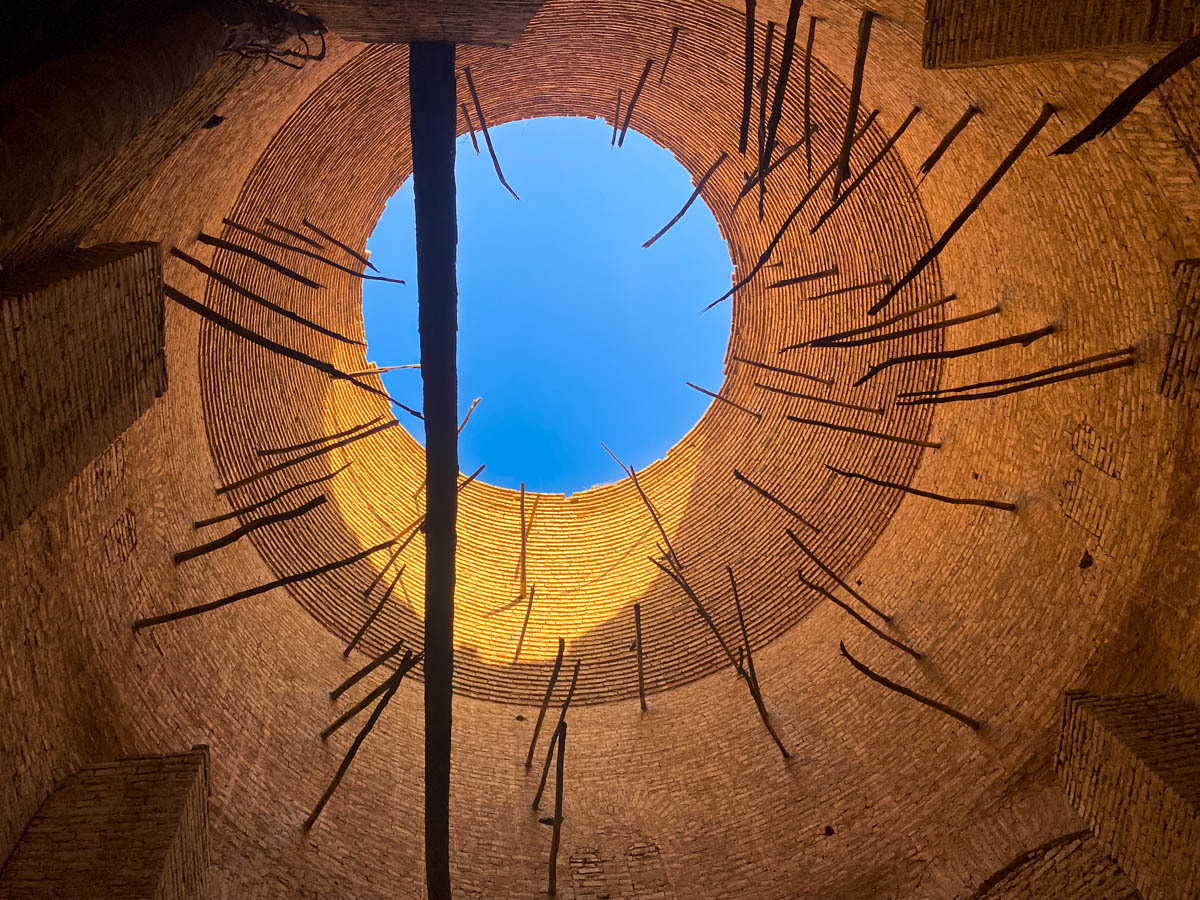
The inside of the Khatmiyah Mosque’s dome.
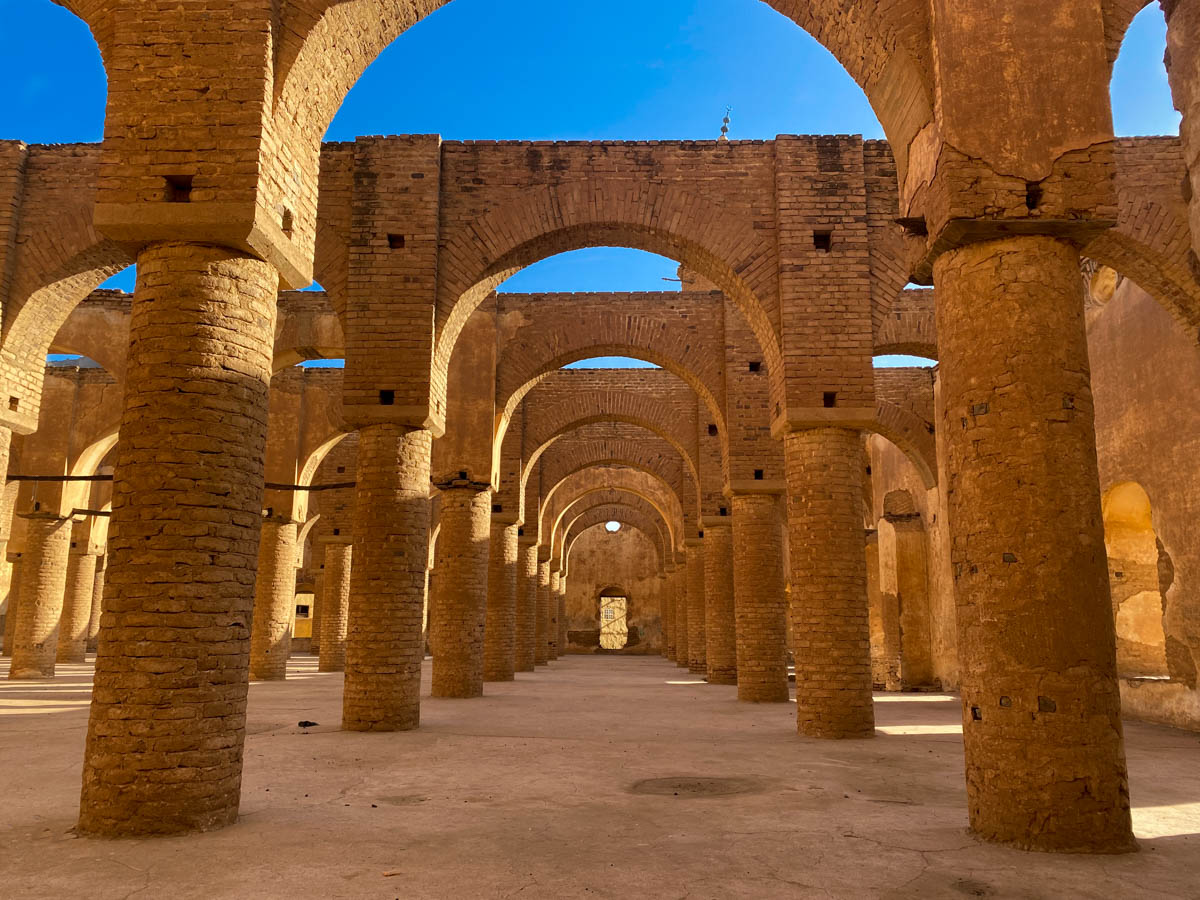
The courtyard of the Khatmiyah Mosque.
Orchard Hike
The Taka mountains are the biggest draw for hikers in Kassala, but there’s also a pleasant hike amongst the orange and mango orchards on the western side to the Gash River that bisects the town. Presuming you’re staying on the eastern side of Kassala, start by crossing the main bridge over the Gash to the western riverbank. You’ll see the orchards on your left immediately after crossing.
A raised dirt track runs parallel to the Gash River with beautiful views over the orchards and the Taka Mountains in the background. You will also see how local farmers live along the way, getting a glimpse into a more rural way of life for Sudanese people. To find the start of the track, after crossing the bridge, continue along the main road away from the river for about 400m until you reach coordinates 15.445322, 36.383817 (here on Google Maps), then turn left.
The orchards follow the banks for the Gash for over 10kms and you can walk for as long as you want. If you’re visiting during the dry season, you can also cross the river bed to the other side. As there are no other bridges, if you’re visiting during the rainy season your only option will be to double back.
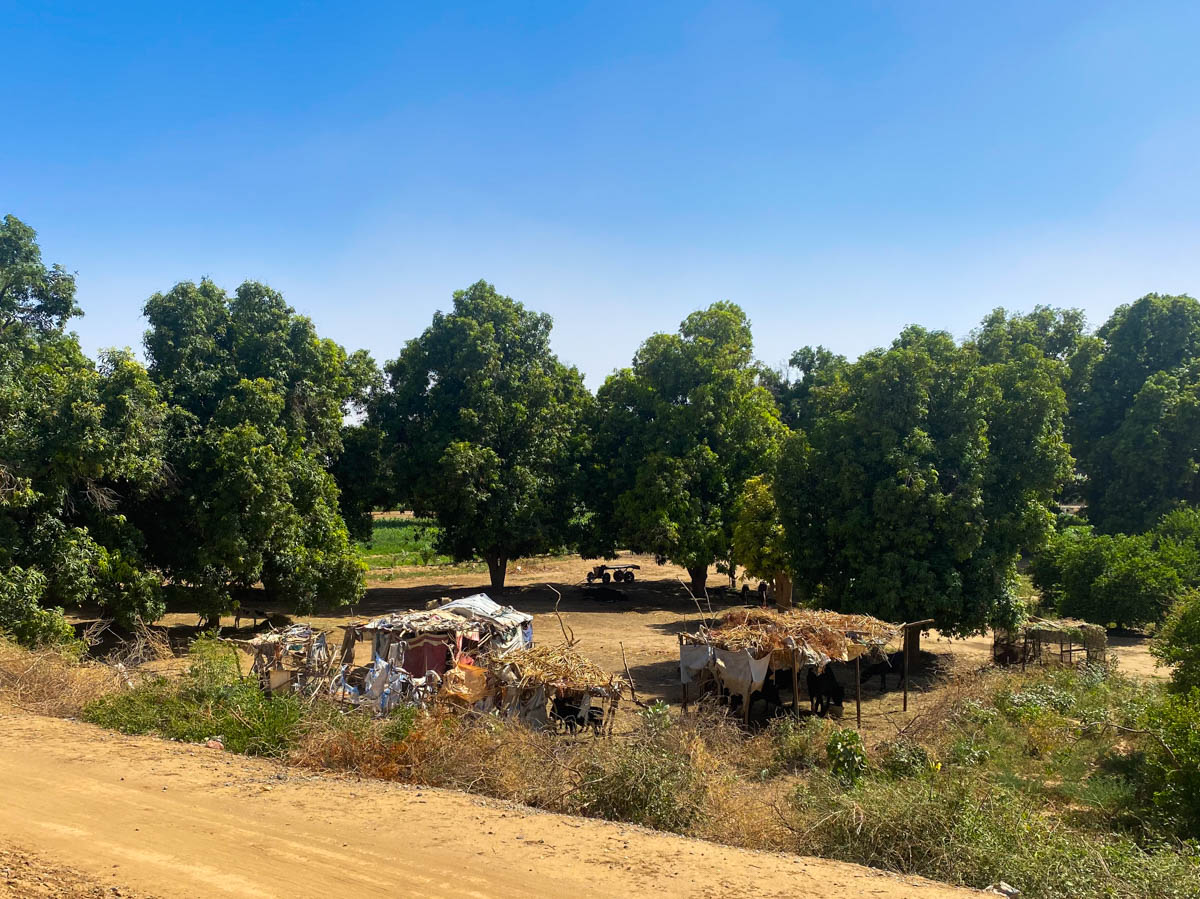
Local farmers live among the trees in the most basic of makeshift huts.
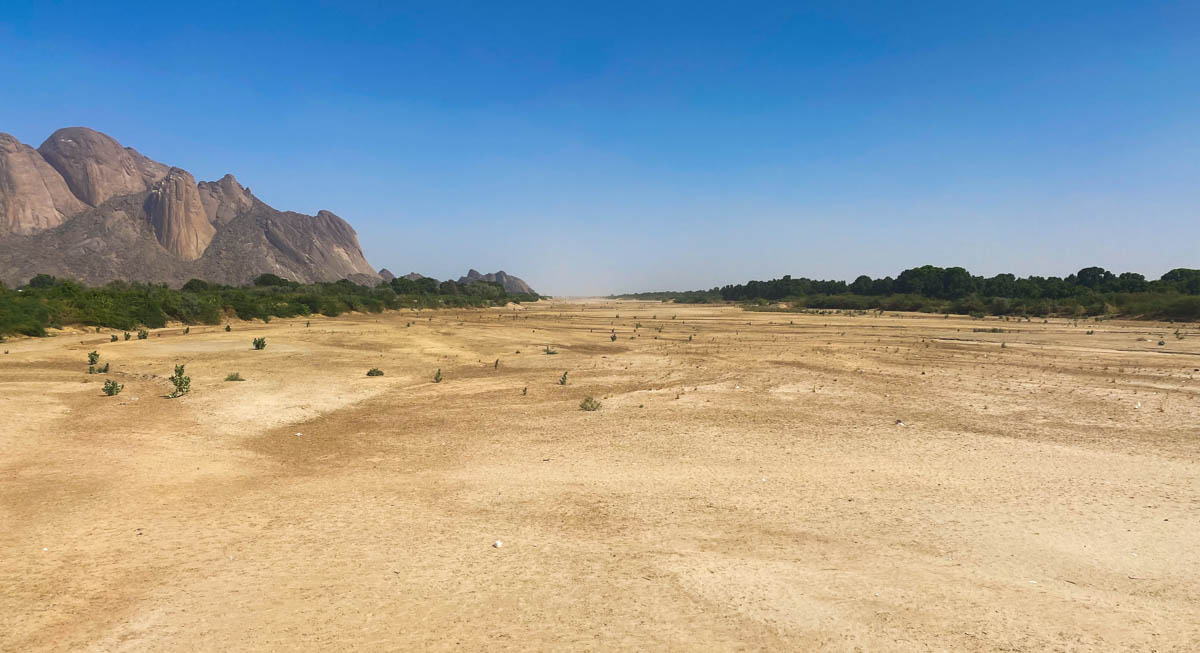
The dry Gash riverbed.
Other Sites of Kassala
Aside from the main sights, just wandering around Kassala is a joy in itself. The main market is bustling and you can buy a huge array of merchandise. I particularly recommend the local goat’s cheese, which I had for breakfast one morning with sliced tomato and bread (I made it myself as it was Ramadan and restaurants were all closed) – delicious. There are also several shops that sell a bewildering assortment of different types of whips (for whipping animals, not the kind that come in a set with a pair of handcuffs). The whip shops are located at 15.456679, 36.396478 (here on Google Maps).
On the western side of the city centre, there is a cute little statue of a traditional Sudanese coffee pot (the location is 15.456759, 36.394301 – here on Google Maps). Speaking of which, be sure to drink plenty of the local coffee, which is traditionally served with popcorn in Kassala! Although the coffee is served on every street corner, not everywhere does it with popcorn. A Couchsurfer took me to a local cafe just up the street from the Fahd Hotel at 15.459363, 36.395391 (here on Google Maps), so check it out if you’re not sure where to go. Warning: the coffee is super sweet (and people often look very confused if you ask for it without sugar!)
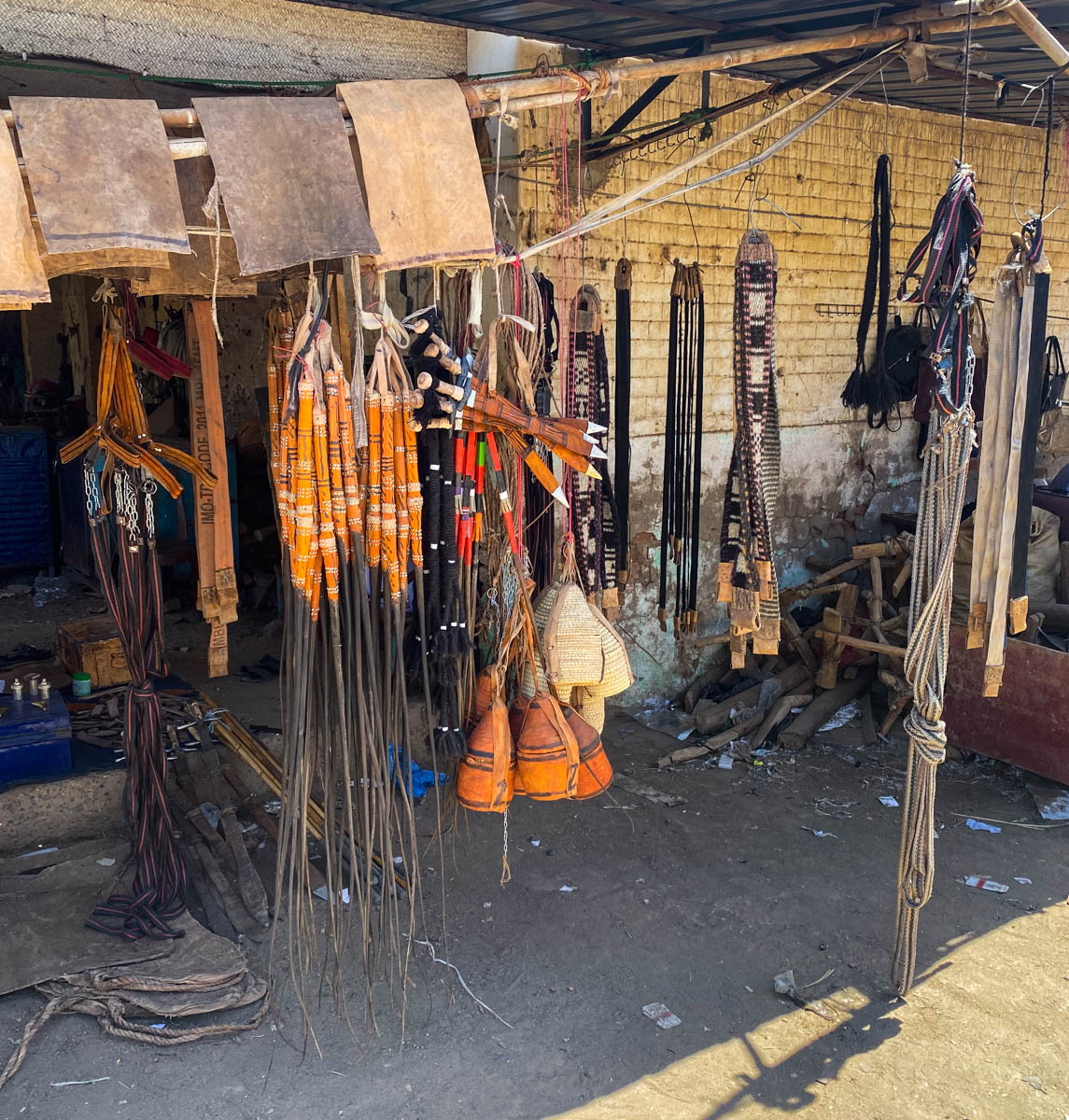
Who knew that Sudan is the place to stock up on toys?
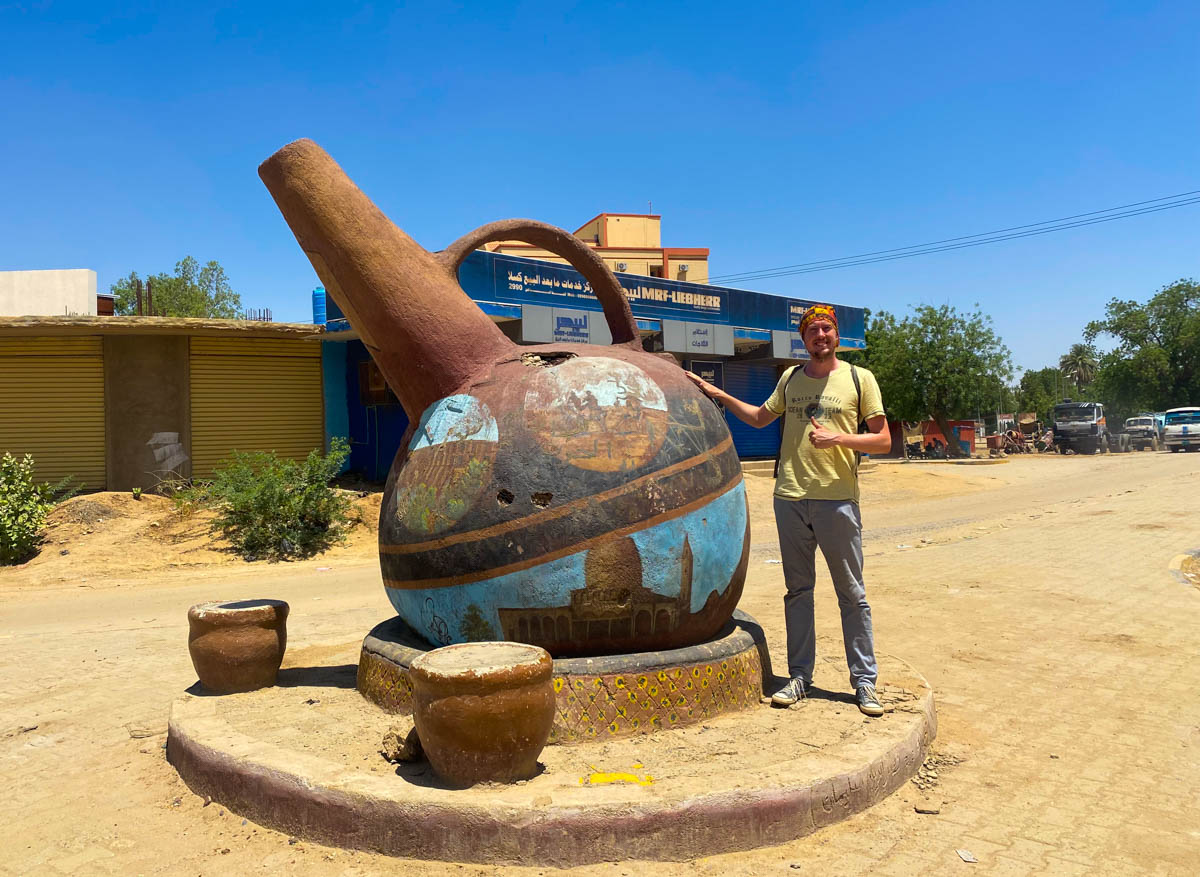
They really love their coffee here, and rightly so, it’s delicious and served with popcorn!
Itinerary: The Hikes and Sights of Kassala in a Day
If you’re not in a hurry, Kassala is a great place to take your time, hang with the locals, and slowly explore the town and surrounding mountains. However, if you don’t, it’s actually possible to do both the main hikes plus the Khatmiyah Mosque in a single day.
Start with the Orchard hike. When you’re roughly parallel with the Taka Mountains (approximately at 15.429118, 36.390946 – here on Google Maps), turn towards the river. If it’s the dry season, you’ll be able to walk right across the riverbed (if it’s the wet season, you’ll have to go all the way back to the main bridge, adding a lot of additional distance).
After crossing the river, continue to the Khatmiyah Mosque. Once you’ve finished looking around, it’s only about another ten minutes to the entrance to the Taka Mountains and you can either chill in the shade of the cafes or continue to hike right up until you can see Eritrea on the other side.
We planned to stay in Kassala for two full days and space out the activities. However, at lunchtime on the first day a local Couchsurfing friend called us and told us that the date of Eid might be changed (due to the visibility of the moon) and that we should leave the next day, otherwise there might not be buses to Khartoum. So we set out at about 2pm following this route and made it all the way to the top of Taka Mountains just in time to watch the sunset. Then we trekked down the other side in semi-darkness. Oh, and it was 42 degrees!
How to Get to Kassala
Kassala is a major city in Sudan and well connected, despite standing alone in the desert far from any other urban area. Buses depart early in the morning to and from Khartoum, Port Sudan and Atbara. Times and prices vary depending on the bus company, but are approximately as follows:
Khartoum to Kassala: $27, 11 hours.
Port Sudan to Kassala: $25, 10 hours.
Atbara to Kassala: $25, 10 hours.
The long-distance bus station in Kassala is located at 15.420728, 36.363074 and marked as Souq ash-sha’abi on Maps.Me. On Google Maps the location here (don’t ask me why it has a photo of a motorbike!). Luckily, you can buy the bus tickets in advance in the city centre, so you can just go to the bus station to catch your bus. We used a ticket office at 15.453284, 36.394796 (marked as Bus Tickets on Maps.Me and located here on Google Maps) to buy our tickets to Khartoum. However, there are many ticket offices in this area, so ask around if this one doesn’t have what you need.
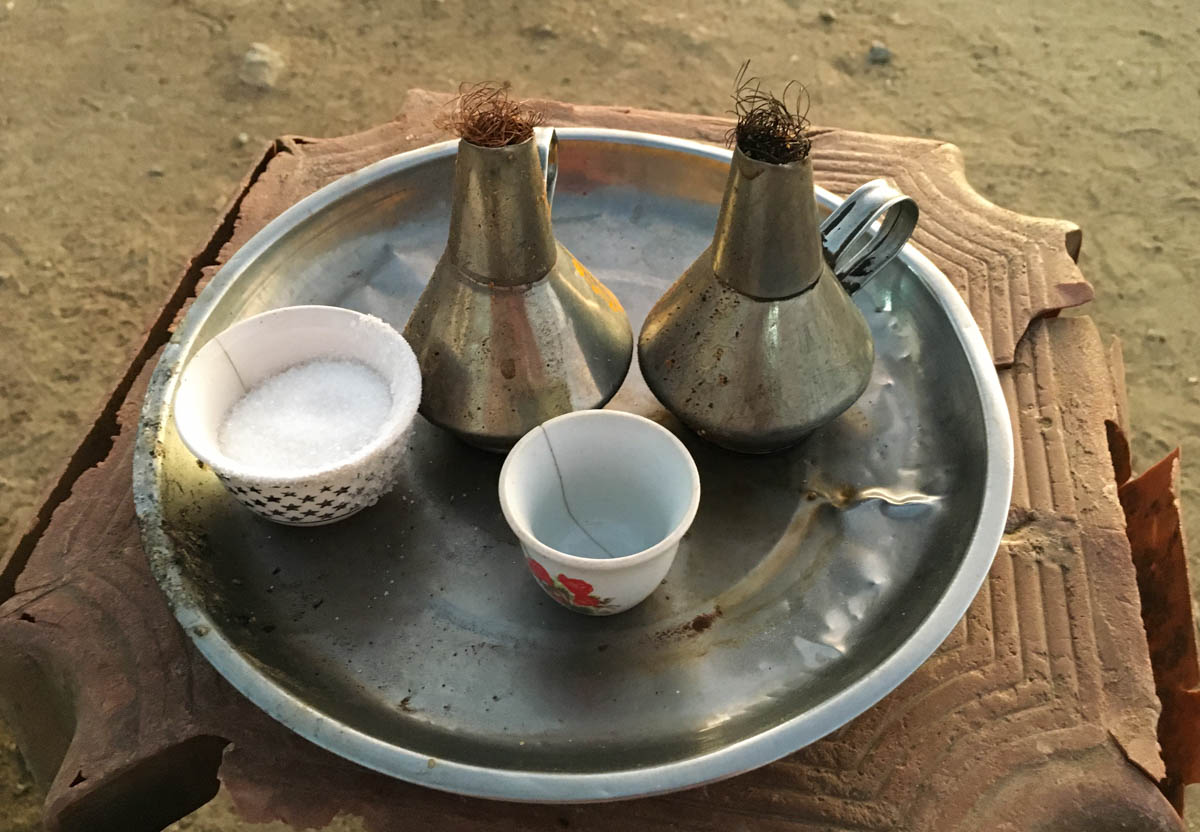
Traditional Sudanese coffee, as served at the local bus station (and on every street corner in Sudan).
Where to Stay in Kassala
There are many hotels in Kassala, mostly clustered around the town centre, which is roughly centred on the central bus station at coordinates 15.456534, 36.398525 (marked on Maps.Me as simply Bus Station and in Arabic only on Google Maps). If you take a public minivan from the long-distance bus station on the edge of town, you’ll end up in this area.
We stayed at the Fahd Hotel, which was basic but cheap and reasonably clean (by Sudanese hotel standards). And, critically, there were no bed bugs, which are grotesquely common in Sudan. The price was $18 for a standard double room. The location is not marked on Maps.Me or Google Maps, but is at coordinates 15.457727, 36.396118 (here on Google Maps, which lists it as an auto parts store!).
Where to Change Money in Kassala
In other cities that we visited in Sudan, we just turned up at a random bank and generally they were happy to change USD to Sudanest pounds for us. However, Kassala was different. The good news is that the banks are open on Fridays. The bad is that we went to about five different banks, but none of them were authorised to exchange currency. Eventually, one gave us adequate directions to the Blue Nile Mashreg Bank, which is authorised. The location is clearly marked on Maps.Me as Blue Nile Mashreg Bank, Kassala (Main Branch). It’s not indicated on Google Maps, but the location is here (coordinates 15.456481, 36.39293).
Safety in Kassala
Sudan, overall, is a very safe country and we never had any issues in Kassala. That said, a local Couchsurfer we hung out with warned us that muggings had become more common, especially when walking alone at night. Sudan is currently experiencing an economic crisis and some people are desperate. We did walk around the town centre at night, but tried to stay in crowded areas. Apply standard safety precautions and you’re likely to be fine.
When to Visit Kassala
The rainy season lasts from May to September, so it’s best to avoid that period. Otherwise, December to February have the lowest average daytime temperatures, ranging between 34 and 36 degrees C (93-97F). Basically, Sudan is seriously hot and Kassala is no different. I visited at the end of Apri, more-or-less the hottest time of the year, and hiked under a scorching 42 degree C (107F) sun. I drank a bucket of water and basted myself in sunblock, but it’s doable.
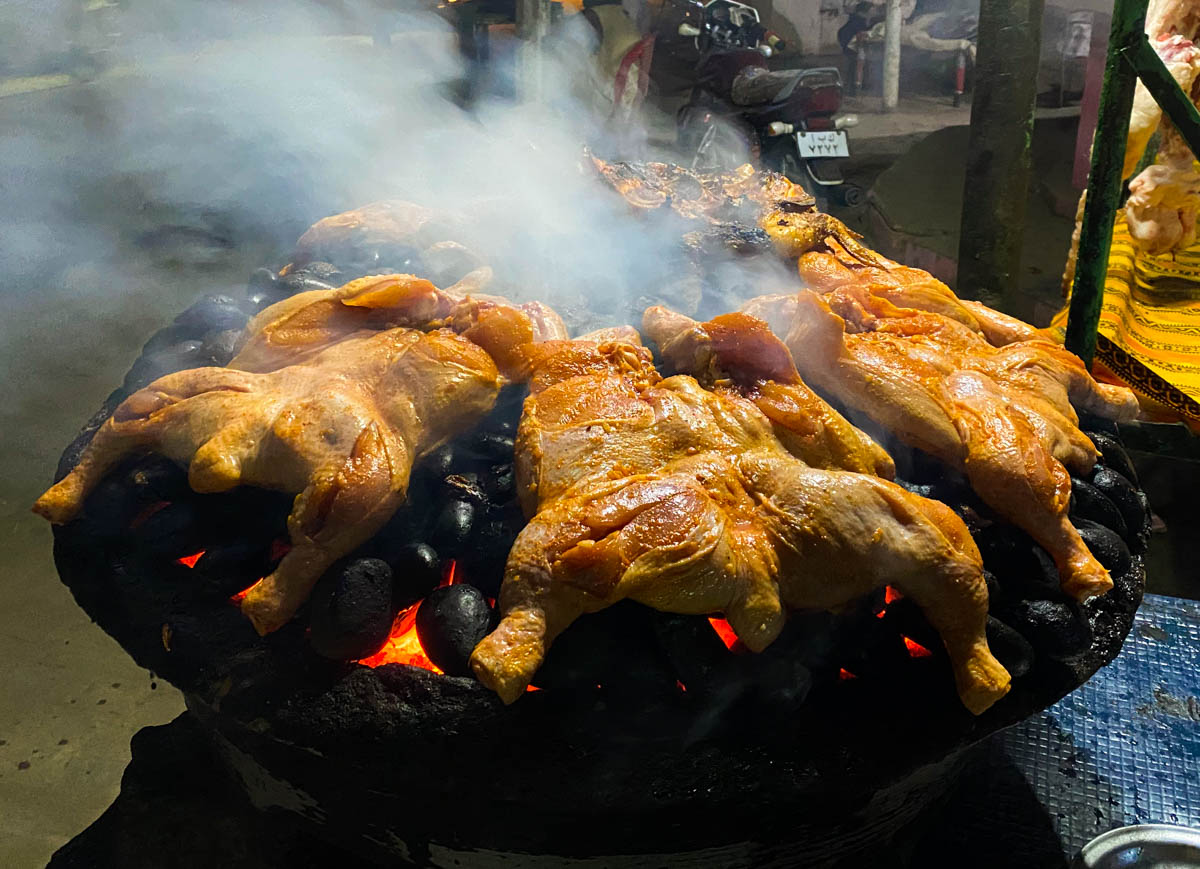
Delicious chicken served on a street corner in Kassala.
Travelling in Kassala During Ramadan
We were in Kassala during Ramadan and it was easier than many of the other cities we visited. The main reason was that food was readily available, at least in the evenings, with a choice of street food and small restaurants around the city centre. Our first night in town we found particularly tasty barbequed chicken at 15.456939, 36.398011 (here on Google Maps), but wander around this area and there are plenty of options.
Some things were closed during Ramadan. We were surprised to find that some hotels were not accepting guests. The cafes at the foot of the Taka mountains were also not operating during the day. However, there were a few people around, so I expect they still opened in the evening.
Read More About Sudan
Sudan is a beautiful and unique country, but not the easiest place to travel. Check out my other Sudan guides for everything you need to know to backpack independently around this crazy country:
What to do in Port Sudan and the Coral City of Suakin
Sudan's Red Sea Coast: Port Sudan and Suakin This travel blog contains everything you need to know to visit Port Sudan and the coral city of Suakin independently and all the best things to do there. It includes the best sights, how to travel there with public...
How to Visit the Meroe Pyramids, Naqa and Musawwarat es-Sufra
How to Visit the Meroe Pyramids, Naqa and Musawwarat es-Sufra This travel guide contains everything you need to know to visit the Meroe Pyramids and the temples of Naqa and Musawwarat es-Sufra independently. It contains detailed information on what to see, how to...

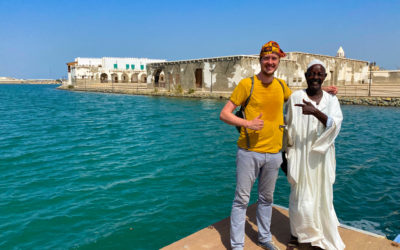
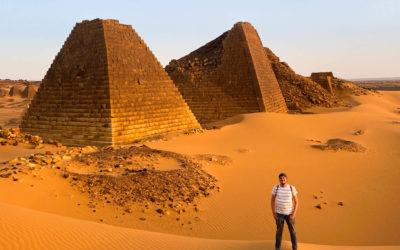
Recent Comments